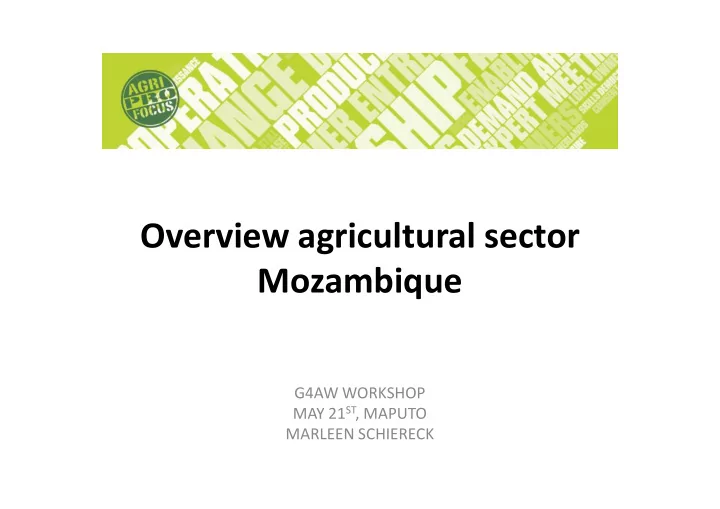

Overview agricultural sector Mozambique G4AW WORKSHOP MAY 21 ST , MAPUTO MARLEEN SCHIERECK
• Outline of the presentation – Characteristics of the Agricultural sector – Challenges for development of the smallholder sector – Foodsecurity – Strategic plans for the Agricultural Sector – Information systems – Questions
Characteristics of the Agricultural sector
• Over 80% of the active population is employed in the agricultural sector • 3.7 million farmers – Of which over 99% are smallholder farmers • 36 million hectares of arable land – Estimated 10% is in use • Of this 90% is cultivated by families • Cash crops occupy just over 5% of the cultivated area
• Use of inputs, technology and staff by smallholders 2003 2008 Users of irrigation 6% 3% Users of animal traction 11% 11% Users of chemical fertilizers 3% 3% Users of pesticides 5% 3% Member of an association 4% 7% Help of extension services 13% 8% Has employees permanently 2% 3% Has employees temporarily 16% 19%
Challenges for development of the smallholder sector
• Rainfall dependence / lack of use of irrigation – Subsistence farming is highly dependent on rainfall in over 95% of the cultivated areas • Impact of recurrent droughts or insufficient rainfall has resulted in significant loss of harvests – Only a small percentage has access to irrigation systems • Also depending on access to energy – Electricity limited or absent in rural areas – Depending on fossil fuels for irrigation – Climate risks • Risk of losing harvest due to unfavorable weather conditions is over 50% throughout the areas of rain fed agriculture south of the Save river and it can reach 75% in the interior of Gaza province • Floods, droughts, cyclones
• Access to credit – Only 2% of the smallholder farmers have access to credit – Banks • Far majority of smallholders is not considered bankable due to the high risks associated with, amongst others, the climate and attitude on repayment of loans • Issue of farmers is that not all banks have financial products on offer that suit them due to high interest rates, limitation to short-term credit – Micro Finance Institutions • Lack of Credit Bureau for Microcredit Operators, dependence on donors – Outgrower schemes • Not-buying risk for farmers, side selling risk for contracting companies
• Productivity – Relatively low compared to regional standards – Yield/ha has been practically constant for the past 50 yrs – Increase in production due to increasing area • Extension services – An estimated 11% of the smallholder farmers is served by extension agents • Infrastructure – Limited road access in the areas with the highest agricultural production, especially during rainy season – No railway system linking the North and the South of the country
• Processing industry – Not strongly developed • Storage capacity – Limited in general and even more close to the production areas – Post harvest losses are high, due to pests and physical deterioration during storage • Organization of farmers – Less then 10% of the farmers is organized in small associations or forums
Foodsecurity
• In Mozambique there is a relation between not making use optimally of the potential of the agricultural sector and the moderate progress in strengthening foodsecurity Food insecurity 35% of the population Chronic malnutrition at national level 43% of the population Chronic malnutrition at provincial level Cabo Delgado, Nampula > 50% of the population Zambezia, Niassa, Tete, Manica > 45% of the population Inhambane, Gaza, Maputo Province > 40% of the population
Strategic plans for the Agricultural Sector
• PNISA National Plan for Investments in the Agrarian Sector, 2013- – 2017 Increasing food production • Increase the market-oriented production • • Enhancing the competitiveness of the agricultural and fisheries producers • Use of sustainable soil, water and forests Developing the institutional capacity of the agricultural • sector and fishing
• PEDSA Strategic Plan for Agricultural Development, 2010-2019 – • Increase agricultural production and productivity and its competitiveness • Improve infrastructure and services for markets and marketing Use land, water, forest and fauna resources in a sustainable • way • Establish a legal framework and policies that are conducive to Agricultural investment Strengthen agricultural institutions •
• ESAN-II – Food and Nutrition Security, 2008-2015 Ensuring food self-sufficiency of the country • • Contribute to the improvement of the purchasing power of households • Reduce the incidence of malnutrition (acute and chronic) by improvement of health, water sanitation and nutrition education and nutrition • Ensuring the progressive realization of the human right to food suitable for all citizens • Increase the ability of households to respond to seasonal variations in the production Physical and economic access to adequate food •
• PDDA Plano Director para o Desenvolvimento de Agronegocio – • Increased use of agricultural inputs • Increase access of farmers to “affordable” credit • Ensuring access to markets Investment in infrastructure, including irrigation, roads and • forms of communication • Strengthening and maintenance of institutions and support services such as extension services, research and innovation programs, agro-processing units and input and output markets • Training of individual and collective producers
Information systems
• Agricultural information systems – Technical Secretariat of Food Security and Nutrition (SETSAN) • Assess food security on a regular basis – Famine Early Warning Systems (FEWS) NET • Market information systems – Agricultural Markets Information System (SIMA) • Aims to provide agricultural market information – to farmers to enable them negotiate for better prices with traders – to traders and processors to identify opportunities – to policymakers for food security planning and policy formulation
Questions? APF-MOZAMBIQUE.NING.COM
Recommend
More recommend